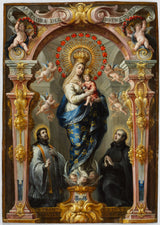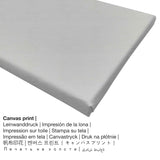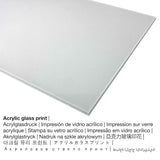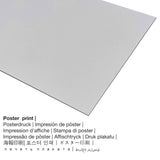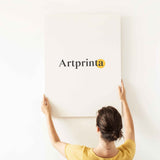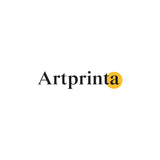Bartolomé Pérez, 1680 - Nne anyị nwanyị nke Ezi Ndụmọdụ - mbipụta nka mara mma
Ụtụ gụnyere. Mbupu gbakọrọ na ndenye ọpụpụ.
Họrọ ihe gị
The product dropdown menu ofers you the opportunity to pick your individual material and size. Pick your favorite size and material among the following options:
- Mbipụta kanvas: A printed canvas material stretched on a wood stretcher frame. Canvas prints are relatively low in weight, which implies that it is easy to hang up the Canvas print without additional wall-mounts. Canvas prints are suitable for all kinds of walls.
- Bipụta akwụkwọ mmado n'ihe kwaaji: The poster is a UV printed cotton canvas with a slightly roughened surface structure, that resembles the original work of art. Please note, that depending on the absolute size of the poster we add a white margin of approximately 2-6 cm around the print, which facilitates the framing with a custom frame.
- Mbipụta ọla (aluminium dibbond): An Aluminium Dibond print is a print material with an outstanding depth. A direct Direct Print on Aluminum Dibond is your best start to fine art prints on aluminum. For our Print On Aluminum Dibond, we print the selected artpiece on the surface of the white-primed aluminum material.
- Mbipụta iko acrylic (nke nwere ezigbo mkpuchi iko): A glossy print on acrylic glass, which is often described as a an art print on plexiglass, will change your favorite original work of art into beautiful home decoration. Further, it is a distinct alternative to canvas or aluminium dibond fine art prints. The acrylic glass protects your chosen art print against light and heat for many more years.
Ederede iwu dị mkpa: We try to depict our products as exact as possible and to illustrate them visually in our shop. Still, the pigments of the printed materials, as well as the print result may differ marginally from the representation on your device's screen. Depending on the settings of your screen and the nature of the surface, color pigments can unfortunately not be printed one hundret percent realistically. Given that all our fine art prints are printed and processed manually, there might also be slight deviations in the motif's size and exact position.
What does the original description of the The Cleveland Museum of Art say about the 17th century work of art created by Bartolomé Pérez? (© - Ụlọ ihe ngosi nka nke Cleveland - Velọ ihe ngosi nka nke Cleveland)
This painting loosely and inventively depicts an actual chapel in the former Jesuit Imperial College in Madrid, which housed a Madonna and Child in gilded and painted wood, a focus of popular devotion. Pérez made temporary decorations for the Spanish court, none of which survive, but the fanciful architecture, curiously inverted obelisks, fruits and flowers, and pastel colors all stem from this side of his work. By representing a polychrome sculpture in two dimensions, Pérez further blurred boundaries between painting and sculpture. This intersection of the spiritual and the real worlds was important in Spanish art of the 1600s.
Background information on this artwork created by the Baroque painter Bartolomé Pérez
N’afọ 1680 Bartolomé Pérez created the baroque work of art. The artpiece was painted with the size: Nhazi: 50 x 40 cm (19 11/16 x 15 3/4 na); Emebereghị: 37 x 26 cm (14 9/16 x 10 1/4 na). Mmanụ na ọla kọpa was applied by the Spanish painter as the technique for the artwork. The artwork's inscription is the following: signed lower left: "B.me. P.z D." In ribbon on top: N. Señora del /Buen Consejo Under figure at left: S. Franco Under figure at right: B.S. Luys. Gonzaga. This work of art is included in the digital art collection of The Cleveland Museum of Art. With courtesy of: Velọ ihe ngosi nka nke Cleveland (nwere ikike - ngalaba ọha). Tụkwasị na nke ahụ, ihe osise ahụ nwere akara kredit: Ịzụta n'aka JH Wade Fund. Na mgbakwunye na nke ahụ, nhazi ahụ dị na Eserese format na a akụkụ ruru nke 1: 1.4, which implies that the length is 29% shorter than the width. The painter Bartolomé Pérez was a European artist, whose artistic style can be classified as Baroque. The European painter was born in 1634 na nwụrụ anwụ na afọ nke 59 n'afọ 1693.
Nkọwapụta nka
| Aha nke ihe nka: | "Our Lady of Good Counsel" |
| Nhazi: | sere |
| Category: | nka ochie |
| Time: | 17th narị afọ |
| Afọ okike: | 1680 |
| Afọ nka: | ihe dị ka afọ 340 |
| Ihe osise izizi: | mmanụ na ọla kọpa |
| Nha nke ihe nka izizi: | Nhazi: 50 x 40 cm (19 11/16 x 15 3/4 na); Emebereghị: 37 x 26 cm (14 9/16 x 10 1/4 na) |
| Akara mbinye aka: | signed lower left: "B.me. P.z D." In ribbon on top: N. Señora del /Buen Consejo Under figure at left: S. Franco Under figure at right: B.S. Luys. Gonzaga |
| Ụlọ ihe ngosi nka: | Velọ ihe ngosi nka nke Cleveland |
| Ebe ngosi nka: | Cleveland, Ohio, United States nke America |
| website: | Velọ ihe ngosi nka nke Cleveland |
| Ikikere nke ihe osise: | ngalaba ọha |
| Site n'aka: | Velọ ihe ngosi nka nke Cleveland |
| Ebe E Si Nweta: | Ịzụta n'aka JH Wade Fund |
Banyere ngwaahịa a
| Ụdị ngwaahịa: | ezi nka mmeputakwa |
| Usoro mmeghari: | dijitalụ mmeputakwa |
| Usoro nhazi: | Mbipụta UV / dijitalụ |
| Nlụpụta: | arụpụtara na Germany |
| Ụdị ngwaahịa: | mmepụta ihe na-achọ |
| Ojiji ngwaahịa: | ihe ndozi ụlọ, nka mgbidi |
| Ndozi onyonyo a: | nhazi ihe osise |
| Oke akụkụ onyonyo: | (ogologo: obosara) 1: 1.4 |
| Ntụgharị nkọwa akụkụ akụkụ: | ogologo bụ 29% mkpụmkpụ karịa obosara |
| Ụdị dị iche iche dị: | akwụkwọ mmado (akwụkwọ kwaaji), mbipụta ọla (aluminium dibond), mbipụta iko acrylic (nke nwere ezigbo mkpuchi iko), mbipụta akwụkwọ. |
| Nhọrọ nke akwa akwa n'elu etiti ihe ndọtị (mbipụta akwa akwa): | 50x70cm - 20x28", 100x140cm - 39x55" |
| Mbipụta iko acrylic (nwere ezigbo mkpuchi iko) nhọrọ nha: | 50x70cm - 20x28", 100x140cm - 39x55" |
| Mbipụta akwụkwọ mmado (akwụkwọ kwaaji): | 50x70cm - 20x28" |
| Mbipụta aluminom (aluminium dibond ihe) nha dị iche iche: | 50x70cm - 20x28", 100x140cm - 39x55" |
| Igwe onyonyo: | mmeputakwa na-enweghị isi |
Ozi izugbe na onye na-ese ihe
| aha: | Bartolomé Pérez |
| Obodo onye nka: | spanish |
| Ọrụ nke onye na-ese ihe: | onye na-ese ihe |
| Obodo obibi: | Spain |
| nhazi ọkwa: | nna ukwu ochie |
| Ụdị nka: | Baroque |
| Afọ ọnwụ: | 59 afọ |
| Afọ ọmụmụ: | 1634 |
| Afọ nwụrụ: | 1693 |
Copyright right, Artprinta (www.artprinta.com)

